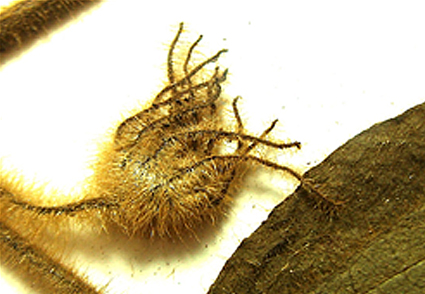Abstract
During our analyses of Lycianthes exsiccates, as part of the taxonomic treatment for the Brazilian flora, a new species was discovered and is described and illustrated here. The species is compared and contextualized within the infra-generic classification of Lycianthes. Analyses of indument and trichomes were performed by stereomicroscopy (SM) and scanning electron microscopy (SEM). The new species, Lycianthes amazonica, is recognized as an endemic species to the Brazilian Amazon, which has its habitat described as secondary formations (capoeira) of terra-firme forests. It is closely related to L. sprucei, with which shares the scandent or vine habit, flexuous branches and ferrugineous indument of glandular trichomes. However, they are distinguished by several morphological features, including trichomes morphology, a sessile inflorescence and calyx appendages of equal length; both species belong to Lycianthes. subg. Polymeris sect. Eulycianthes ser. Glanduliferae. The description of this species expands the total number of Lycianthes species to the Brazilian Amazon to six, as well as thirteen to Brazil. The affinities of Lycianthes amazonica with its related species, distribution, ecology, and conservation status are discussed. Additionally, a lectotypification of Lycianthes sprucei, a species closely related to L. amazonica, is proposed.
References
<p>Barboza, G.E. & Hunziker, A.T. (1992) Estudios sobre Solanaceae XXXIII. El género <em>Lycianthes</em> en la Argentina. <em>Darwiniana</em> 31: 17–34.</p>
<p>Bitter, G. (1919) Die Gattung <em>Lycianthes</em>. <em>Abhandlungen Herausgegeben vom Naturwissenschaftlichen Verein zu Bremen</em> 24: 292–520.</p>
<p>Brandegee, T.S. (1914) Plantae Mexicanae Purpusianae, VI. <em>University of California Publications in Botany</em> 6: 51–77.</p>
<p>Carvalho, L.D.A.F. (1997) Diversidade taxonômica das Solanáceas no Estado do Rio de Janeiro (Brasil): 2. <em>Lycianthes</em> e <em>Solanum</em>. <em>Albertoa</em> 4: 281–300.</p>
<p>Carrero, G.C., Fearnside, P.M., do Valle, D.R., Alves, C.S. (2020) Deforestation Trajectories on a Development Frontier in the Brazilian Amazon: 35 Years of Settlement Colonization, Policy and Economic Shifts, and Land Accumulation. <em>Environmental management </em>66: 966–984. https://doi.org/10.1007/s00267-020-01354-w</p>
<p>Costa-Silva, R.& Agra, M.F. (2018a) Lectotypifications of six taxa in <em>Lycianthes</em> (Solanaceae). <em>Phytotaxa</em> 348: 297–300. https://doi.org/10.11646/phytotaxa.348.4.6</p>
<p>Costa-Silva, R. & Agra, M.F. (2018b) Updates on <em>Lycianthes</em> (Solanaceae): A new species from Brazil, notes on taxonomy, and a key to identification of Brazilian species. <em>Nordic Journal of Botany</em> 36: 1–8. https://doi.org/10.1111/njb.01949</p>
<p>D’Arcy, W.G. &Averett, J.E. (1996) Recognition of tribes Capsiceae and Physaleae, subfamily Solanoideae, Solanaceae. <em>Phytologia</em> 80: 273–275. https://doi.org/10.5962/bhl.part.15536</p>
<p>Dean, E., Mcnair, D.M., Castillo-Campos, G., Starbuck, T., Anguiano-Constante, M.A., Mawdsley, K., Pérez, M.V., Archila, F. (2019) Identification of the Mexican species of <em>Lycianthes</em> series <em>Piliferae</em> (Capsiceae, Solanaceae) and the rediscovery of <em>Lycianthescaeciliae</em>. <em>Phytotaxa</em> 425: 163–189. https://doi.org/10.11646/phytotaxa.425.3.6</p>
<p>Dean, E., Poore, J., Anguiano-Constante, M.A., Nee, M.H., Kang, H., Starbuck, T., Rodrígues, A., Conner, M. (2020) The genus <em>Lycianthes</em> (Solanaceae, Capsiceae) in Mexico and Guatemala. <em>PhytoKeys</em> 168: 1–133. https://doi.org/10.3897/phytokeys.168.51904</p>
<p>Dunal, M.F. (1813) <em>Histoire Naturelle, Médicale et Économique des Solanum, et des genres qui ontété confundus avec eux</em>. Chez Renaud, Montpellier, 248. pp. https://doi.org/10.5962/bhl.title.164866</p>
<p>Dunal,M.F.(1816)<em>Solanorum generumque affinium synopsis, seu Solanorum historiae editionis secundae summarium, ad characteres differentiales redactum, seriem naturalem, habitationes stationes que specierum breviter indicans </em>24. 51 pp.</p>
<p>Dunal, M.F. (1852) <em>Solanum </em>Section I <em>Pachystemonum</em>, Subsection V <em>Lycianthes.In:</em> De Candolle, A.P. (Ed.) <em>Prodromus Systematis Naturalis Regni Vegetabilis.</em>VictorisMasson, Paris, pp. 156–183.</p>
<p>Hassler, E. (1917) <em>Lycianthes</em> in Solanaceae Austro-Americanae Imprimis Paraguarienses. <em>Annuaire du conservatoire et du jardin botaniques de Genève </em>20: 173–183.</p>
<p>IUCN (2019) <em>Guidelines for using the IUCN red list categories and criteria</em>, version 2019.14. Prepared by the Standards and Petitions Committee. Available from: http://www.iucnredlist.org/documents/RedListGuidelines.pdf (accessed 2 December 2020)</p>
<p>Instituto Nacional de Pesquisas Espaciais (INPE). (2020) <em>Portal Terra Brasilis</em>. Available from: http://terrabrasilis.dpi.inpe.br/app/dashboard/deforestation/biomes/legal_amazon/rates (accessed 13 June 2021).</p>
<p>Knapp, S. (1983) Sectional nomenclature in <em>Solanum</em> (Solanaceae). <em>Taxon </em>32: 635–636. https://doi.org/10.2307/1221743</p>
<p>Linnaeus, C. (1753) <em>Species Plantarum. </em>Vol. 1. Laurentii Salvii, Holmiae [Stockholm], Sweden, 560 pp.</p>
<p>Linnaeus, C. (1767) <em>Mantissa plantarum</em>. Generumeditionis VI. et specierum editionis II. Laurentii Salvii, Holmiae [Stockholm], Sweden, 142 pp. https://doi.org/10.5962/bhl.title.119809</p>
<p><em>Lycianthes</em> in Flora do Brasil (2020) Jardim Botânico do Rio de Janeiro. Available from http://floradobrasil.jbrj.gov.br/reflora/floradobrasil/FB14660 (accessed 14 Feb 2021).</p>
<p>QGIS. (2021) QGIS Geographic information system. QGIS Association. Available from: http://www.qgis.org (accessed 14 April 2021).</p>
<p>Ruiz,H. & Pávon, J.A. (1799) <em>Flora Peruviana, et Chilensis, sive descriptions et icones</em> 2. Typis Gabrielis de Sancha. Madrid. pp. 35, t. 167, f. b.</p>
<p>Rodal, M.J.N., Sales, M.F., Silva, M.J.D. & Silva, A.G.D. (2005) Flora de um Brejo de Altitude na escarpa oriental do planalto da Borborema, PE, Brasil. <em>Acta Botanica Brasilica</em> 19: 843–858. https://doi.org/10.1590/S0102-33062005000400020</p>
<p>Seithe, A. & Sullivan, J.R. (1990) Hair morphology and systematics of <em>Physalis</em> (Solanaceae). <em>Plant systematics and evolution </em>170: 193–204. https://doi.org/10.1007/BF00937703</p>
<p>Soares, E.L.D.C., Vignoli-Silva, M., Vendruscolo, G.S. & Mentz, L.A. (2008) Solanaceae nativas no Rio Grande do Sul, Brasil: Listagem I. <em>Revista Brasileira de Biociências</em> 5: 1050—1052.</p>
<p>Stehmann, J.R., Mentz, L.A., Agra, M.F., Vignoli-Silva, M. & Giacomin, L. (2013) <em>Solanaceae</em> in <em>lista de espécies da flora do Brasil</em>. Jardim Botânico do Rio de Janeiro. Available from http://floradobrasil.jbrj.gov.br/jabot/floradobrasil/FB14660 (accessed 5 May 2021)</p>
<p>Theobald, W.L., Krahulik, J.L.& Rollins, R.C. (1979) Trichomes description and classification. <em>In:</em> Metcalfe, C.R. & L. Chalk, L. (Eds.) <em>Anatomy of the dicotyledons</em>, Claredon Press, Oxford, pp. 4053.</p>
<p>Thiers, B. (2021) Index Herbariorum: A global directory of public herbaria and associated staff. New York Botanical Garden’s Virtual Herbarium. Available from http://sweetgum.nybg.org/ih/ (accessed 10 March 2021)</p>
<p>Turland, N.J., Wiersema, J.H., Barrie, F.R., Greuter, W., Hawksworth, D.L., Herendeen, P.S., Knapp, S., Kusber, W.-H., Li, D.-Z., Marhold, K., May, T.W., McNeill, J., Monro, A.M., Prado, J., Price, M.J. & Smith, G.F. (eds.) (2018) <em>International Code of Nomenclature for algae, fungi, and plants (Shenzhen Code) adopted by the Nineteenth International Botanical Congress Shenzhen, China, July 2017</em>. Regnum Vegetabile 159. Glashütten: Koeltz Botanical Books. https://doi.org/10.12705/Code.2018</p>
<p>Udulutsch, R.G., Souza, V.C., Rodrigues, R.R. & Dias, P. (2010) Floristic composition and identification keys to the lianas from Caetetus Ecological Station, São Paulo state, Brazil. <em>Rodriguésia</em> 61: 715—730. https://doi.org/10.1590/2175-7860201061412</p>


